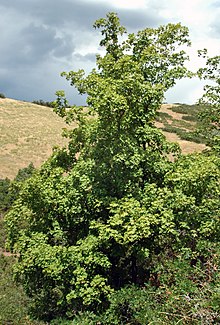Acer grandidentatum
| Acer grandidentatum | |
|---|---|

| |
| Bigtooth maple, Wasatch Mountains , Utah
| |
| Scientific classification | |
| Kingdom: | Plantae |
| Clade: | Tracheophytes |
| Clade: | Angiosperms |
| Clade: | Eudicots |
| Clade: | Rosids |
| Order: | Sapindales |
| Family: | Sapindaceae |
| Genus: | Acer |
| Section: | Acer sect. Acer
|
| Series: | Acer ser. Saccharodendron |
| Species: | A. grandidentatum
|
| Binomial name | |
| Acer grandidentatum | |

| |
| Generalized natural range | |
Acer grandidentatum, commonly called bigtooth maple or western sugar maple,[2][3] is a species of maple native to interior western North America. It occurs in scattered populations from western Montana to central Texas in the United States and south to Coahuila in northern Mexico.
Description
It is a small to medium-sized
The flowers appear with the leaves in mid spring; they are produced in corymbs of 5–15 together, each flower yellow-green, about 4–5 millimetres (3⁄16–3⁄16 in) diameter, with no petals. The fruit is a paired samara (two winged seeds joined at the base), green to reddish-pink in color, maturing brown in early fall; each seed is globose, 7–10 mm (1⁄4–3⁄8 in) diameter, with a single wing 2–3 cm (3⁄4–1+1⁄4 in) long.
-
Flowers and emerging spring leaves in early April inSalt Lake County, Utah
-
Mature summer leaves in August
-
Fall leaf color in late September
Taxonomy
It is closely related to Acer saccharum (sugar maple), and is treated as a subspecies of it by some botanists, as Acer saccharum subsp. grandidentatum (Nutt.) Desmarais.[6][7]
Distribution and habitat
It grows from the Rocky Mountains in southeast Idaho, through Utah[4] and further south.
It commonly grows in limestone soils but can adapt to a wide range of well-drained soils, from sand to clays to even white limestone areas. It prefers sheltered canyons, valleys, and the banks of mountain streams, primarily at higher elevations but occasionally at lower elevations in disjunct locales such as the southern edge of the Edwards Plateau in Texas and in the Wichita Mountains of southwestern Oklahoma.
Cultivation
Although it is found in
It is occasionally planted as an ornamental tree, valued for its drought tolerance and ability to grow in rocky landscapes.
Uses
The sweetish sap is used in western North America to make maple sugar.[8]
See also
References
- . Retrieved 13 November 2021.
- ^ https://landscapeplants.oregonstate.edu/plants/acer-grandidentatum
- ^ https://www.fs.usda.gov/database/feis/plants/tree/acegra/all.html
- ^ OCLC 1141235469.
- ^ "Lost Maples State Natural Area 2007 Lost Maples State Natural Area Foliage Color Change Report". Texas Parks & Wildlife Department. 31 October 2007. Retrieved 23 December 2023.
- ^ USDA, NRCS (n.d.). "Acer grandidentatum". The PLANTS Database (plants.usda.gov). Greensboro, North Carolina: National Plant Data Team.
- ^ "Acer grandidentatum". Germplasm Resources Information Network. Agricultural Research Service, United States Department of Agriculture. Retrieved 1 January 2018.
- ISBN 0-394-73127-1.
External links
 Media related to Acer grandidentatum at Wikimedia Commons
Media related to Acer grandidentatum at Wikimedia Commons- "Acer saccharum grandidentatum". Plants for a Future.




